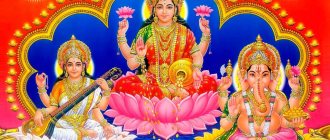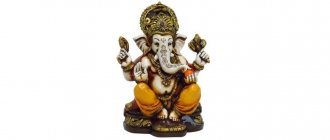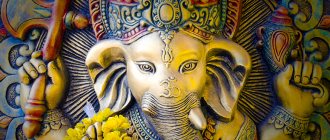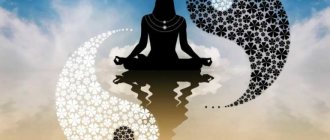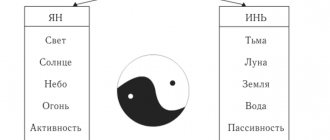Translated from Sanskrit, the name of the god Shiva means “good”, “all-understanding”, “merciful”. Despite this, Shiva is one of the most revered and controversial deities in India. He is part of the triad of supreme gods, performing special functions.
And if Brahma is the guardian of the world, and Vishnu monitors order and harmony, then Shiva, paradoxically, acts as the creator and destroyer of the Universe, and Shiva’s riding animal (vahana) is the white bull - Nandin. Many Indians consider this god the most powerful of all and, it should be noted, this is quite justified. How do Shiva combine the powers of creator and destroyer? What do myths and ancient epics tell about his abilities?
A huge sculpture of Shiva in the Indian city of Rishikesh
What does Shiva look like?
When starting to get acquainted with Shiva, I suggest immediately paying attention to his appearance. Shiva is the god who is impossible not to recognize among other deities of Hinduism. Most often he is depicted in the lotus position, although images of dancing Shiva are often found.
The latter option has become a popular symbol of India, the unspoken emblem of this country. Shiva has fair skin, long dark hair, twisted at the top of his head into a bun (called jatta).
There are extraordinary “decorations” on the god’s neck, legs and wrists. These are the snakes that are entwined around Shiva. They are considered a symbol of unity with nature and the warlike courage of God. In addition, coiled snakes are associated with time, namely the flow of time from the past to the future. According to legend, the sacred river Ganges lives in the hair of the god, and his gaze is like a starry night.
Unlike the same Vishnu, dressed in a royal outfit, Shiva resembles an ascetic (which, in fact, he originally was). His clothing is tiger or elephant skin. The forehead of the god is also decorated with symbolic marks.
The image of the third eye is inscribed on it, as well as three lines that Shiva makes with the ashes left over from the burning of corpses. Probably, such a detail seems creepy for Europeans, but in India everything is different. Such “paint” is the identification of Shiva with the omnipotent deity that reigns in different worlds, reminds us of unity with our ancestors, with our past.
In Indian temples you can also find an unusual image of Shiva, called Ardhanari. Half of it belongs to the man and half to the woman. This image of God speaks of the integrity of principles (female and male), which unites Shiva. Only he is able to give harmony to the vain world he created. But he can easily destroy everything around him. Why is this so?
Symbols-attributes of Shiva
In accordance with his incarnations, Shiva is depicted with various attributes, symbolizing the power of this particular image:
- Shiva’s body is naked and covered with ash - this is a symbol of the source of the universe; he goes beyond the boundaries of earthly life, his physical state, without experiencing suffering.
- Shiva's matted hair is the unity of spiritual, physical and mental energy.
- Ganga, who lives in his hair , is a woman-wife, from her mouth flows a stream of water that falls to the ground. This is a symbol of the fact that with the help of it, Shiva eliminates ignorance, sins and gives peace, purity and knowledge.
- The moon in Shiva's hair is a symbol of mind control.
- Shiva is depicted with three eyes: one eye is the sun, the second eye is the moon, and the third is a symbol of fire.
- Shiva's eyes are half open - a symbol of the endless flow of life, which has no beginning or end - it is a cyclical process, and it is eternal. When he opens his eyes, a new round of earthly life will begin; when he closes them completely, the world is destroyed in order to be born again.
- The snakes entwined around Shiva's neck symbolize time - the past, present and future.
- Rudraksha beads (dried fruits of an evergreen tree) are a symbol of Shiva's steadfastness in upholding the law and order of the universe.
- The right hand of God , giving blessing and wisdom, it also destroys evil and ignorance.
- Shiva's trishula (trident) is his energies (shahti): knowledge (jnana), action (kriya) and desire (icchha).
- The drum (damaru) is a symbol of the form of existence - physical and spiritual.
- The bull Nandi , accompanying Shiva, is his constant means of transportation.
- The skin of a tiger is a symbol of hidden energy and victory over lust.
- Shiva sitting on the scorched earth is a symbol of his control over physical death.
Shiva - creator god and destroyer god
Indians believe that it was Shiva who stood at the origins of time. The great god managed to create the Universe with the help of dance - Tandava. By performing sacred movements in a vigorous rhythm, the god can create, protect or destroy the world. But why destroy what has been created?
Hindu philosophy gives us the answer to this question. According to her, everything in the Universe has its own lifespan, and she herself is no exception. When the world's time expires, Shiva begins to perform the Tandava of destruction. The warlike mighty god destroys the world he previously built so that a new one begins to be born in its place.
Shiva performs a sacred dance, tandava - a symbol of creation and victory of good
Shapes of Shiva
In ancient times, people knew about the sublime nature of Shiva and identified its three states:
Arupa is beyond form. Rupa-Arupa is formless form. Sarupa - having form.
Arupa is a state in which there is no form, image or color, it transcends space and time, there is nothing to rely on in trying to describe the state of arupa. This manifestation is possible only when the Universe has not yet been created.
arupa state of Shiva is that which is beyond the manifest.
Six distortions do not operate in this state: Adhi - Antha (beginning and end). Sancocha - Wistara (contraction and expansion). Prasarana - Abhisarana (extension and concentration) These characteristics are applicable only to the manifested Creation.
The arupa state expresses Shiva as Chaitanya or pure consciousness which exists but is not manifested and is at rest. This state is the source of all Creation, and all deities owe their origin to this state. Hence the name Mahadeva - the source of all deities, the God of gods.
Rupa-arupa is a formless manifestation in a form or a form arising from another form. Transitional state from sukshma (subtle) to sthula (gross).
Sarupa is the state in which Shiva manifests in various forms. Sa means "with" or "accompanied by." Thus sarupa means "with form" or in the manifested state.
The strongest among the gods
Many Indian legends are dedicated to Shiva and his story. Many of them emphasize the power of God. Once he even entered into a competition with two of his supreme “colleagues”. Shiva turned into a huge pillar of fire, which had no beginning or end.
Then Brahma took the form of a swan and flew high up, but could not reach the top of the sacred Shiva Lingam (pillar). Vishnu, in turn, turned into a boar and began to dig the ground under the pillar. He was never able to reach the bottom. Since then, the gods have recognized that Shiva is the most powerful among them.
The legend of the birth of the god Shiva
Let us tell you some interesting stories about the birth of Shiva. Each of them is different from each other.
The first story of Lord Shiva says that he was born in response to Brahma's prayers for a son. The prayers were heard, and a blue-skinned deity was born. The child ran near Brahma, crying and asking him to give him a name. Brahma named the child Rudra, but the boy did not stop; the father was forced to give the boy 10 more names. In total there were 11 names and 11 incarnations.
Another legend says that the multi-armed Shiva (Rudra) - the result of Brahma's anger and malice - emerged from his eyebrows. This was the reason that the most negative energy of all the energies of Hinduism became the nature of the newborn deity.
Another legend tells that Brahma is the son of Vishnu. Brahma had 4 sons who did not want their own offspring. God became angry, and a blue-skinned child appeared from between his eyebrows. He was given a name - Rudra and 10 more names and lives, Shiva is one of the names.
The last legend says that Vishnu is the father of Brahma. At the moment of Brahma's birth, there were demons nearby who wanted to destroy God. Because of this, Lord Shiva appeared at the place where Vishnu’s eyebrows meet with a trident in his hands and protected Brahma.
Shiva Family
It seems to me that the legends about the family of Shiva belong to the most striking myths of India. According to legends, Shiva has three consorts. The first was the beautiful Sati, who sacrificed herself, proving to her father her love for the god Shiva, whom he did not recognize.
Parvati became Shiva's second wife (and she was the rebirth of Sati). This love story turned out to be difficult for the girl. Immersed in deep grief due to the loss of his beloved, Shiva did not want to see what was happening in the world. Only Parvati’s endless dedication, her love and devotion helped God see what he had not noticed before.
Shiva's third wife is Ganga. This is a sacred river that passes through three worlds, crossing heaven, earth and mysterious dungeons. Myths tell that she begins her journey among the stars, where she once saw Shiva and fell in love with him. The beautiful river asked him to weave it into his hair, and Shiva agreed. Since then, Ganga has been a part of God himself.
God Shiva
God Shiva is contrasts: contemplation and action, creation and destruction, anger and mercy. His image combines many aspects, which is not surprising, because he is considered the Absolute, and the Absolute contains everything. He is Mahayogi - the "great yogi", and also Nataraj - the "king of dance", but also Mrityunjay - the "conqueror of death", seated on the throne of Mount Kailash in the Tibetan Himalayas. This is a sacred place of power, which is revered not only by yogis and followers of Shaivism, but also by people who study the energies of the Earth, its influence on the human condition, his energy and consciousness. Knowledgeable people say that Kailash is truly unlike anything they have seen and experienced before. This is an indescribable experience, after which even big skeptics change their point of view and cast aside all doubts.
On the territory of India there are many places associated with Shiva, and all of them in one way or another can be called places of power. One of the most revered is the Ganga River. It is believed that a sacred river descends through the hair of the god Shiva, so bathing in it brings purification, both external and internal, spiritual.
Brahma, Vishnu, Shiva - trinity
The Hindu/Vedic Trinity, otherwise called Trimurti, consists of three gods: Brahma, Vishnu and Shiva, with Brahma as the creator, Vishnu as the preserver, and Shiva as the destroyer. This is the real Trinity of Vedism, and yet they are inseparable, these are different manifestations of the one.
Some branches of Shaivism, such as Kashmir Shaivism, see Shiva as a combination of all aspects: creator, preserver and destroyer. For Shaivites, he is Everything. Others perceive it as analogous to the Holy Spirit in Christianity. Shiva is the absolute Reality. Despite the fact that in the minds of mythology experts the god Shiva is associated with destruction, this does not at all mean destruction, understood as something negative. Our culture forces us to think this way. In fact, destruction can be interpreted in different ways: leaving the past, breaking with it; the cessation of the old way of life and the transition to a new stage, because in order to start something, you must first end the previous one.
Such a concept as the destruction of worldly vanity and even death also plays an important role. Shiva is the Absolute, therefore the word “destruction” is just one of the names, one hypostasis, because in the next he is the embodiment of mercy and compassion.
Worship of Shiva
The traditional symbol of Shiva is a lingam, shaped like a small pillar. During festivals dedicated to this god, the lingam serves as a sanctuary. It is decorated with flowers, garlands and sprinkled with oils.
The main celebration dedicated to Shiva - Mahashivratri, “The Holy Night of Shiva” - is one of the most important holidays in India. On this day, after sunset, believers go to temples where they bring gifts to God.
Indians believe that it is very important to stay awake all night during the holiday and meditate. For this, Shiva will give a person good luck and prosperity.
The statue of Shiva in Murudeshwar, its height is more than 40 meters
Legends about Shiva are a huge part of Indian culture; they can be told endlessly. This god may seem both merciful and formidable, but he always defends justice and the principles of truth. Shiva is both a great father, a protector god, a formidable warrior, and a kind patron, and therefore it is not surprising that his cult has not lost its power from ancient times to the present day.
How big is Shiva
Although Shiva is not a person, but if one wants to see how great the consciousness of Shiva is, then one can say: “Brahmananda vyapta deha.”
What does it mean?
Shiva's body transcends galaxies. The entire Universe is his body. All stars, nebulae make up hair, thousands of Suns together make up eyes. Water is the belly. The snake represents intelligence. The world is filled with millions of unique vibrations associated with the mind, planets and even food. Everything is interconnected.
The Rudrastakam says:
Namaam-Iisham-Iishaana Nirvaanna-Ruupam Vibhum Vyaapakam Brahma-Veda-Svaruupam | Nijam Nirgunnam Nirvikalpam Niriiham Cidaakaasham-Aakaasha-Vaasam Bhaje-[A]ham |
Salutations to Ishana (another name of Shiva), whose form is the state of the highest nirvana (cessation of all desires and passions, the highest bliss), Who manifests Himself in form, although, in essence, He permeates everywhere; and His form embodies the supreme knowledge of Brahman present at the root of the Vedas. Who abides constantly in His own Self, which is beyond the three gunas (sattva, rajas and tamas), and which is beyond any vikalpas (change and variety), and which is free from any movement (due to desires, etc. .), Who resides in the Chidakasha sky (Spiritual sky); I worship this Ishan (Shiva).
Family
Sati became the daughter of Daksha and the future wife of Shiva . Her name is mentioned in Puranic Hindu texts. Sati's fate is tragic. Her father refused to invite Shiva for a significant sacrifice. Then she renounced Daksha and burned herself to ashes with sacrificial fire.
Sati was reborn in the Himavata family (Himalaya mountains) in the form of Parvati (daughter of the mountains). By performing special austerities she managed to win the love of Shiva again.
As a result of mutual feelings, two sons were born to them: Skanda, a warrior deity, and Ganesha, a learned deity. The entire family is called Shiva Parivar. They are depicted with four hands, in which they hold various attributes and vahanas. Indian mythology idealizes the trinity of Shiva-Parvati-Ganesha. This is how the divine family is embodied. Some texts mention another child of Shiva - daughter Manasi.
Parvati's sister (Ganga) is also considered the wife of Shiva. According to the Vedas, Ambika is called the sister of Rudra (Shiva), but in later literature she began to be identified with the wife of Shiva.
Dance of Shiva
The dance of Shiva Nataraja means the movement of the Universe; the pose of balance in the dance, brilliantly expressed by the ancient master, symbolizes the eternity and inviolability of this cosmic process. The strands of hair fluttering on either side of Shiva's head indicate the emission of divine energy.
With his foot, Shiva tramples the prostrate dwarf - the demon Alas-mara (some researchers see Shiva's enemy Miyilaku in the dwarf), who personifies the forces of evil and ignorance brought about by illusion, while Shiva is also considered the “king of knowledge.”
With inspired skill, the ancient Indian sculptor brought grace, beauty and vitality to Shiva Nataraja - the most symbolic and strictly canonized image of the supreme Indian deity.
...But the statue of Shiva will not return from the restoration workshop: it was taken away in a heavy box in a jeep, and in its place was a younger copy doll. Although beautifully made, it is a copy...
And the real Shiva Nataraja is now in the Ginet Museum in Paris.
God symbol
We have already mentioned the word “lingam” many times. It is with him that Shiva is associated. God was often simply designated by this concept. What is it?
Lingam translated from Sanskrit means “sign, mark”. This is a cylindrical sculpture with a round, less often hemispherical top. Many researchers tend to see it as a symbol of an erect phallus. Ancient Hindus considered the linga to be an abstract image of a deity.
Often it is depicted not by itself, but in pairs with a circle or square, which represents “yoni” (vagina, womb). Today it is generally accepted that these two objects are the oldest mention of the unity of masculine and feminine principles. Only in Hinduism was the masculine eternal and static, and the feminine temporary, changeable and material.
Some scholars see in the linga a prototype of a stambha, a special sacrificial pillar. Cattle that were preparing for slaughter were tied to it.
There is a special ritual that includes washing the lingam, reciting mantras and offering sacrificial fruits, flowers, incense and other permitted items.
MYSTERIOUS SHIVA. "To the Dancing Shiva"
Starting from the X-XI centuries, the image of Shiva began to be interpreted completely differently in meaning and form. Now among the images of the deity, the main place is given to “Dancing Shiva” (Shiva Nataraja).
A unique statue of Shiva Nataraja was found during archaeological excavations carried out near the Shivarampuram temple complex, built around 1200. The found bronze statue of Shiva was well preserved, and therefore was exhibited in the temple for several days for public viewing, and then it was supposed to pass into the hands of restorers.
For several days, from morning until dark, there was literally no free space near the temple. There were crowds of local residents and foreign tourists, small merchants scurrying briskly between them, feeding themselves from the sale of soft drinks.
At the entrance to the temple, Indians took off their shoes and stepped barefoot onto the clean marble floor. In the round hall of the temple there is the main object of the cult of Shiva - the lingam, around which a ritual is carried out for people to borrow divine power that promotes health, productive longevity and procreation.
Popular articles: Tofik Dadashev’s ability to accurately guess other people’s thoughts
MYSTERIOUS SHIVA VIDEO
Shiva is a yogi who knows what cannot be known.
Shiva, Adi Guru, Adiyogi - are these all names of some god, person or something else? The word "Shi-va", says Sadhguru, means "that which is not"...
The most powerful mantra of Shiva.Shiva Mantra
Svyatoslav Dubyansky, researcher of esoteric traditions, professional writer, author of a series of books on self-development, artist, Master...
SHIVA - THE DESTROYER
Is Shiva nothing more than a mythical Hindu God who gave ancient people a way to describe an incredible cataclysm or is he something...
Symbolism and attributes of God in Buddhism
In the religion of Buddhism, the image of Shiva has multifaceted meaning. It is represented in different forms and symbols. The most famous image is the dancing deity.
This is the six-armed god of dance. The image shows a god dancing at the center of the entire universe. All gestures and poses are filled with the main meaning - the destruction of the Universe. This is a symbol that time does not stand still. It is constantly in motion, flowing and changing.
- Blue skin symbolizes ashes, the beginning of the Universe.
- Stripes on the forehead, throat and shoulders are a symbol of overcoming one’s ego.
- Braided hair is a symbol of the connection of energies: physical, spiritual and mental.
The deity has many attributes, each of which is filled with meaning.
The main attribute of Shiva is the lingam. This is the divine phallus, the source of all life in the Universe. The lingam is placed on a base that represents the feminine principle, the womb.
- The six-armed deity holds a drum in one of his hands. The personification of the first sound of the Universe. All other sounds originated from the drum.
- Shiva holds a trident in his hands. This attribute indicates action, gaining knowledge.
- It is believed that the right hand of Shiva bestows blessings and strength on people. The hand that conquers evil.
- Snakes are depicted on the neck. This is a symbol of eternity. Time past, present and future are connected into one.
- In the hair, the Moon shows the need to control your mind and feelings.
- Eyes half closed. This speaks of the cyclical nature of life. Life is born and dies to be reborn again.
- Shiva is depicted with three eyes. They represent the sun, moon and fire. Death to the one whom Shiva looks at with his third eye.
- The deity's faithful companion is the bull. The personification of the power of the earth serves as a vehicle for God.
How many arms does Shiva have?
Shiva is depicted as a deity with four or eight arms . Why does he need so much? The meaning is quite symbolic and has nothing to do with a real person, i.e. he did not have five heads and four arms.
A small Damaru drum is placed in the palms of Shiva - it sounds to the beat of the Universe. The other hand holds the holy fire of Agni, which cleanses and recreates the world anew.
Shiva is also often embodied in statues with a trident. Multi-armedness was not given to this deity by chance. Two hands hold the symbols of Damara and Agni, the others are folded in poses of approval, dominance and strength. The sound of the drum is considered the progenitor of all existing sounds. Thanks to Shiva, the sound “Om” appeared, which later became a mantra. The entire essence of the Universe is concentrated in its sound.
Spouse
Admirers of Hinduism are familiar with the name of the wife of the deity Shiva - Parvati . In Sanskrit पार्वती, pārvatī? "mountain". This is just one of her names. She is also known as the good form of Devi Shakti (feminine creative energy). Her other good name is Gauri. Hard forms of Devi exist under the names of Kali, Shyama, Chanda, Durga.
In the image of Parvati one can discern the features of Shiva's first wife Sati. She is known as the daughter of the king of the mountain peaks Himavat and the heavenly maiden Menaka Parvati (daughter of the mountains). She later became the mother of the god Ganesha, depicted as an elephant.
According to legend, Parvati should have a child from Shiva who will defeat the demon Taraki. But Shiva was not interested in Parvati and did not appreciate her devotion and unrequited love. Sati ended her life by self-immolation, and Shiva stopped being interested in other women. Sati's soul passed into the form of Uma-Parvati, but he could not figure it out. All attempts by Uma to win the feelings of Shiva were unsuccessful.
Legendary meditation course without payment We recommend! The most popular meditation course for beginners in Russian. More than 100 thousand people have already learned to meditate. Try it yourself. Read more.
The supreme gods feared that no one could defeat Taraki, so they sent Kama to Shiva. With the help of Kama (the god of love), he should have developed feelings for Parvati. Kama shot an arrow of love at Shiva while he was dozing. But Shiva always had a third eye, with which he noticed the arrow and destroyed Kama. Since then, the god of love has no physical incarnation. And Parvati began to engage in asceticism.
One day a brahman came to her and began to scold Shiva. Parvati flew into a rage and rushed at the brahman, protecting her beloved. She did not know that Shiva himself came to her in the form of a brahman. So he wanted to test her loyalty. After this incident, Shiva married Parvati and they had two sons: Ganesha and Skand , who eventually defeated Taraki.
